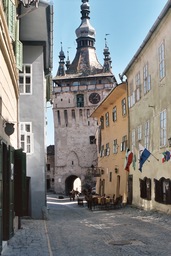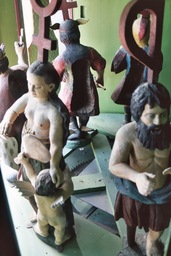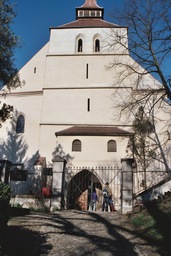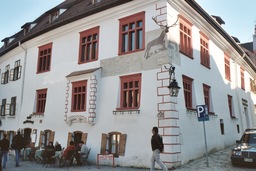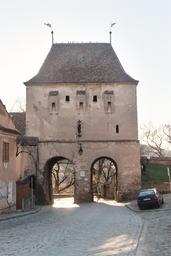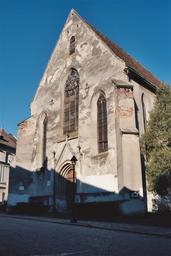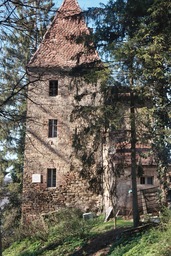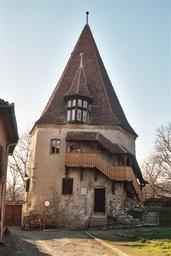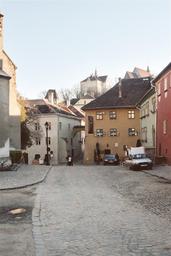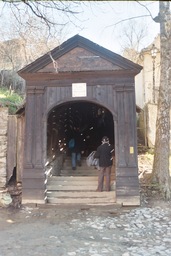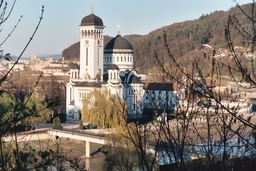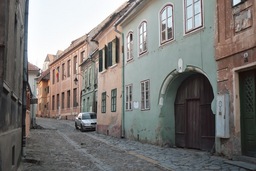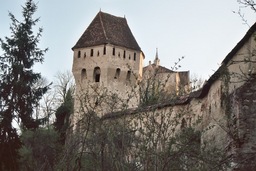|
Click to see larger pictures |
The Clock Tower
Among all Sighisoara's towers, the Clock Tower is the most impressive and the most picturesque. Its role was to be the main gate into the citadel and to house the town's council. It was built in the second half of the 14th century and expanded to 64m height in the 16th century. After a big fire in 1676 (when the town's gunpowder deposits exploded) the roof of the tower was restored to the present Baroque shape, and in 1894 the colourful tiles were added. The four small corner turrets (also seen in other Transylvanian towns) symbolize the fact that the town had judicial autonomy, and the "right of sword" (ius gladii) which was the right to decide on capital punishment. The clock was installed in the 17th century (my next tip talks about the clock in more detail). The tower houses the town's History Museum which describes the Sighisoara's old life. The museum is spread on five levels; make your way to the wooden balcony at the top of the tower where you can look out over the town with its terra-cotta roofs and painted houses. On the way to the balcony one can also see the clock mechanism.|
Click to see larger pictures |
The Clock of the Clock Tower
In 1604 the tower was equipped with a wooden horologe which was remade in 1648 by Johann Kirschel. He equipped the clock with two big dials (one on each facade of the tower) and with two groups of wooden figurines arranged in niches. The figurines are moved by the clock's mechanism. On the citadel side we see the Goddesses of Peace holding an olive branch, accompanied by a drummer who is beating the hours in his bronze drum; above them are the Goddess of Fairness holding a balance and the Goddess of Justice with a spade accompanied by two angels representing Day and Night. Some sources say that the Justice and Fairness symbolize the fact that the town had judicial autonomy and the right to dictate capital punishment. At 6 AM the angel symbolizing the day comes out, marking the begining of the working day and at 6 PM the angel symbolizing the night comes out carrying two burning candles in his hands and marking the end of the working day and the arrival of the evening.Looking over downtown there is a second niche holding a figurine which some say represents the executioner and a second drummer. Above them there are seven figurines representing the pagan gods who personified the days of the week: Diane, Mars, Mercury, Jupiter, Venus, Saturn and the Sun. These figurines are sitting on a wheel and they move at midnight marking the change of the day. Like the tower's turrets, the figurines indicate the fact that at the time the horologe was installed the rustic Baroque style was the fashion in Transylvania. The clock still works, complete with the rotating painted wooden figures, one for each day of the week. The present mechanism of the clock is newer, dating from 1906. The clock was modernized with an electric engine in 1964. The niche with figurines representing the days is visible from inside the Clock Tower. We visited Sighisoara on a Thursday and the picture that we took shows Venus and Saturn showing the days that followed.
|
Click to see larger pictures |
The Church on the Hill (Bergkirche)
This beautiful Gothic church dominates the hill at the southern end of the citadel. It can be reached by climbing the 175 steps of the covered wooden Scholars' Stairs which dates from 1642. The building of the church started in 1345 and ended in 1525, 180 years later. The church was recently restored by the same German foundation that restored the House with Stag. The church was completely painted on the inside but in 1776 it was decided to destroy the old painting provided that exact copies should be made on parchment. Unfortunately the copies were lost. The recent restoration brought back fragments of the late 15th century frescoes. They look so fragile, lost as they are in a sea of white paint. Also inside the church there are beautiful religious sculptures and paintings like the pulpit carved in 1480, an old stone holy water front dating from the 15th century as well as shrines brought from the churches of Saes and Cund.|
Click to see larger pictures |
The House With Stag
The House with Stag gets its name from a stag head fixed on the corner of the building. This type of construction is specific to the Transylvanian Renaissance of the 17th century. The house was recently restored and it looks very beautiful; the restoration revealed the external mural painting showing the stag's body and the inscription. Nowadays, the building houses a modern pension, a cafe-restaurant with traditional dishes and a Romanian-German cultural centre. It's worth spending a few moments to observe the architectural details of the facade|
Click to see larger pictures |
The Taylors' Tower
The taylor's guild was the richest in town and this can be seen in the imposing tower that carries its name. Built in the 14th century, the tower was initially as tall as the Clock Tower but its upper part was destroyed in a fire in 1676, when the town's gunpowder deposit which was located in this place exploded. The Taylor's Tower is the second access road into the citadel, an entrance consisting of two vaulted galleries, which used to have huge oak gates with iron lattice. The tower was restored in 1935.|
Click to see larger pictures |
The Monastery Church
The Monastery Church is located in the Citadel Square not far from the Clock Tower. The church, which is built in Gothic style of the hall-churches with 2 naves and 2 rows of pillars, belonged to the Dominican Monastery. The monastery used to be placed to the north of the church; it was built at the beginning of the 13th century and was demolished at the end of the 19th century. Its place was taken by the present town hall. The church was restored in the 15th century and then again after the big fire of 1676. The last repairs were done in 1894 and 1929 when the church aquired its present day look. The church holds valuable objects like a bronze front dating back to 1440, a stone door frame carved in 1570 in the Transylvanian Renaissance style and built into the northern wall of the church, a collection of 17th century oriental carpets donated by merchants and a fine altar piece from 1680. The organ was built in 1680 in Baroque style by the same artists that carved and painted the altar, the sculptor Johannes West and the pilgrim painter Jeremias Stranovius. The organ is used even today in many concerts organized in the church.|
Click to see larger pictures |
The Rope Makers' Tower
The Rope Makers' Tower is part of the old fortification on top of the hill. Its role was to defend - together with the Goldsmith's Tower - the north-west corner of the hill. It is believed that the tower is one of the oldest buildings in Sighisoara, dating from the 13th century. Its foundations are on the pre-Saxon citadel walls; the tower has a simple square plan. Nowadays the tower is the home of the guardian of the Evangelic cemetery on the hill.|
Click to see larger pictures |
The Shoemakers' Tower
The Shoemakers' Tower is located in the north-eastern part of the town; it was mentioned in documents dating from the mid 16th century but it was totally rebuilt in 1650 being one of the recent towers of the town. It bears the influence of the Baroque architecture, being short, with a hexagonal base with sides of different lengths. It has a picturesque look due to its roof which resembles a pointy helmet and which bears on one side a small tower of observation.|
Click to see larger pictures |
The Vlad Dracul House
The Vlad Dracul House is located in the Citadel Square, close to the Clock Tower. This ocher-colored house is the place where Vlad Dracul (the father of Vlad the Impaler) once lived and where Vlad the Impaler was born. Vlad Dracul was a knight of the Order of the Dragon (hence his name - Dracul means Devil in Romanian). Today the house serves as a restaurant.|
Click to see larger pictures |
The Covered Stairway
Next to the School Street there is a covered wooden staiway named the "Covered Stairs" or "Schoolboys' Stairs". The stair was built in 1642 to facilitate the schoolchidren's way to the School on the Hill during winter. Originally the stairs had 300 steps, but today their number was reduced to 175. The Covered Stairway leads also to the Church on the Hill.|
Click to see larger pictures |
The Orthodox Cathedral
The Orthodox Cathedral is located on the northern shore of the Tarnava Mare, and is accesible by a footbridge. The cathedral, which is dedicated to the Saint Trinity was built in 1934-37 in Byzantine style. The buiding is painted in black and white in an attractive way and features a dome and a tower. The inside was painted by painter A. Demian. Mass is held daily except Monday.|
Click to see larger pictures |
The Streets and Houses of the Citadel
One of the things that we liked the most in Sighisoara was to walk the long and narrow cobbled streets lined with faded pink, green, and ocher houses. Each house deserves a look as each one of them is different than the others and has something worth seeing. Some look like simple craftmen's houses while others look like houses that belonged to the rich. Since the citadel is still inhabited is interesting to see how life goes on within its walls. Everybody goes about their business as they did centuries ago. And if you happen to find yourself alone on one of the streets, with no car or other sign of the modern world around, you'll start to feel as you've suddenly woke up in the 16th century.|
Click to see larger pictures |
